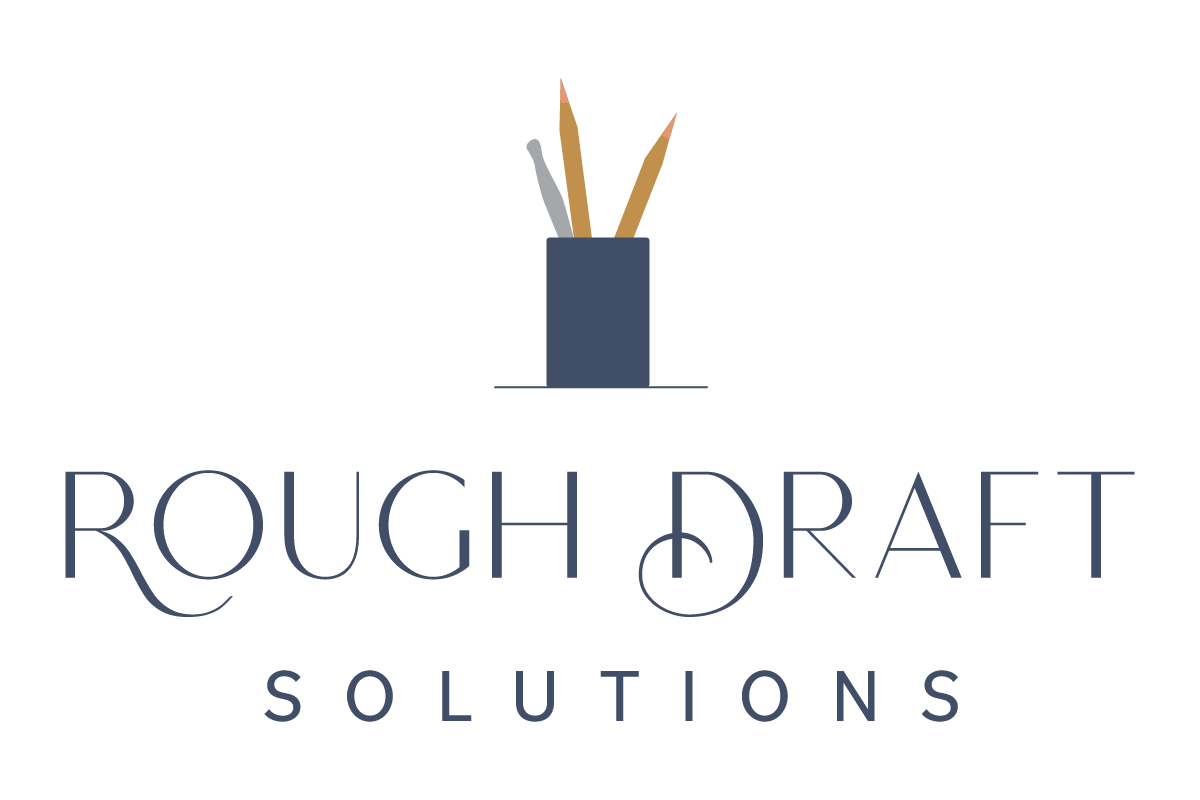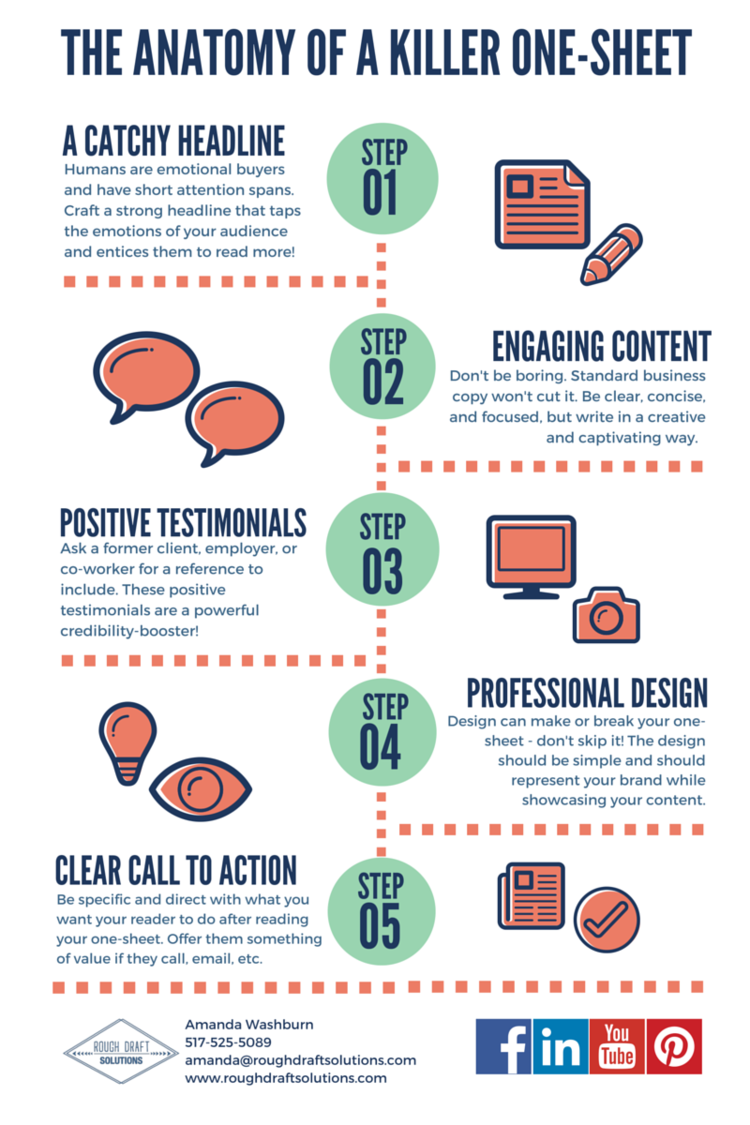Many business owners want to showcase the products or services their company offers, but aren’t sure how. When you have a variety of offerings, it’s easy to create brochures that have too much information and are not that enticing. What you need is a marketing piece that is focused, easy-to-read, and compelling.
Your business needs a one-sheet (or a series of them!).
Keep reading to find out what exactly a one-sheet is, get the ultimate one-sheet checklist, and learn how you can use this tool productively for your business.
We recently launched our one-sheet copywriting worksheet! If you are looking to create a one-sheet but don’t want to spend the $$ to hire us to craft your message from scratch, this is the perfect tool for you! Quick, affordable, easy!
What is a one-sheet?
A one-sheet is a single-page document that showcases a specific product or service with the goal of promotion. Think of a one-sheet as a snapshot of a particular part of your business that includes the most relevant and valuable information for a specific target audience.
A one-sheet is not meant to summarize all of your services, but instead to highlight one focused part of your business. If you sell multiple products, you would create a one-sheet for each product. A one-sheet is a tool designed specifically to spark potential clients’ interests through a message that is clear, focused, and concise.
Your one-sheet can be used to capture more clients, to show current clients the variety of services you offer, and as a tool for referral partners when they recommend you.
What should a successful one-sheet include?
Over the last few years, we have received a lot of interest in one-sheets. This marketing piece gives business owners the focus they need to create a marketing piece that is goal-oriented and centered on answering their customers' questions. Here are six things you need to include when creating a one-sheet.
1. A clear goal:
The most important element of creating a useful one-sheet is to have a specific goal in mind. If you start by creating a strong goal, your one-sheet will be positioned to be successful in the long run. What do you want the outcome of this one-sheet to be? An increase in consultation requests? More awareness about your products? Additional strategic partnerships? More email subscribers? Setting a clear goal will help you determine what content you need to include.
2. A catchy headline:
Your headline may be the single most important content on your one-sheet. The headline is likely the first thing your potential customer will read and it has the power to draw them in or turn them away. Since one-sheets are commonly used in busy settings (networking events, presentation seminars, client meetings, etc.), a strong and focused headline is a must-have to get you in the door.
When brainstorming headlines, focus on the problem your customer has or the solution you’re offering. Use powerful and emotion-inducing words to pull your reader in. Ask yourself if your headline creates a sense of urgency. If your headline is boring or just the name of your product, your one-sheet will likely end up in the trash.
3. Engaging content:
No one will read boring content. Your one-sheet must be compelling and interesting to read - get away from that boring sales copy! And while this may seem counter-intuitive, the most effective one-sheets are the ones with as few words as possible. Now, that doesn’t mean that you don’t have ENOUGH content. You simply want to strip down your message to the most important information that your potential customer needs to know to make them ask for a follow-up conversation. Make sure to use language that offers value and support, but at the same time, don’t overwrite.
The goal is to have a focused message on one part of your business (a specific product or service, or a particular target audience). You want to offer enough information that they believe you are credible and a viable option to meet their needs, but not give them enough information to make a decision without speaking to you. Surprise your reader by having a well-crafted message that adds something positive to their day.
4. Positive testimonials:
There is a lot of debate out there about testimonials these days. Many pragmatic people argue testimonials are lame because you’d never include a negative review on a marketing piece. However, when faced with a buying decision, many business owners prefer to have someone else validate the product or service they are considering purchasing.
By including a focused, specific, and positive testimonial on your one-sheet, you provide a bit of external validation. Do your best to only include a testimonial that is relevant to the services your one-sheet is about. Also, limit yourself to only one or two testimonials.
5. Professional design:
Similar to your headline, the design can make or break your one-sheet. If the layout and colors are dated, boring, or sloppy, you will turn your reader away. Consumers see amazing design on a daily basis, while your one-sheet doesn’t have to be a piece of fine art, it must be professional.
The colors and patterns should also be consistent with your other marketing materials so that your customers begin to recognize your style. Work with a professional designer to create a piece that highlights your content, is easy on the eyes, and is inspiring to look at.
6. A clear call to action:
Your call to action is usually the last thing on your one-sheet. This is where you give your potential customer directions on what to do next. Whether you want them to set up a consultation, make a donation, or visit your website, make sure you are clear and specific. Your customers typically won’t take the next step on their own without some form of guidance. Make it easy for them to know what to do and how to get in touch!
Here is an infographic you can print out to make sure you stay on the right track.
How to use a one-sheet for your business
Relatively easy and affordable to pull together, there are several ways to use your one-sheet.
Bring it to professional events and presentations and hand out to potential customers
Give it to business partners and new business connections
Include it with reports, invoices, and proposals
Make it a downloadable PDF on your website
At RDS, we give a stack of our one-sheets to our referral partners. That way, if they meet someone who needs help with content, they have our information readily available. We also bring them to seminars, workshops, and formal networking events. One-sheets are great leave-behinds and conversation starters!
Overall, a one-sheet can help your business communicate about the solutions you offer and heighten your customer’s experience by offering clear and focused information.





